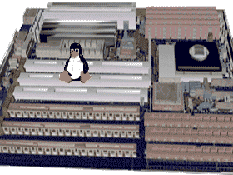
Processor and Motherboards
Here is a rule of thumb about processors - Go for a processor two or three steps behind the current state of the art.
Why? Because of the way manufacturers' price-performance curves are shaped. The top-of-line system is generally fool bait for corporate executives and other people with more money than sense. Chances are the system design is new and untried - if you're at the wrong point in the technology cycle, the chip may even be a pre-production sample, or an early production stepping with undiscovered bugs like the infamous Pentium floating point problem. You don't need such troubles. Better to go with a chip/motherboard combination that's been out for a while and is known good. It's not like you really need the extra speed, after all.
In addition to all that if you buy a top of the range Pentium 4 3.46GHz (currently around £700) you will just be stunned as in a few months when the price drops like a brick and the new all singing all dancing SuperChip©® comes out. If you go for a lower down the line product the profit margins are already at the minimum so the price is unlikely to drop so quickly - although it may drop out of production!
We have already gone on about why there is no need to keep up with the speed demons when it comes to processors but, and this is a big but, sometimes you will need to stay relatively current in order to make the most of the newer motherboards and RAM chips. Also, from a financial point of view there is very little advantage in going for the really low end of the spectrum (have you even seen P60's on the market!) so we need to find a happy medium between price and speed.
Also, one day you might end up doing 3D graphics or running a nuclear power plant on your PC!
Looking over the options, it seems like an AMD Athlon XP 2800+ with 333MHz FSB and 512 kb cache meets our needs and is ideally priced. Ebuyer has them for £68.99, Dabs.com stocks them for £87.78 and Watford Electronics £87.71.
This needs to be supported with the mother board, which for our needs will be a Asus A7V8X-X SKT A KT400 which has 8x AGP and built in sound card and LAN. Prices range from £29.37 (Dabs.com), £30.72 (Ebuyer) or £40.35 (Watford).
Adding these two together gives us a cost of £99.71, leaving us with £435.39 towards our final goal.